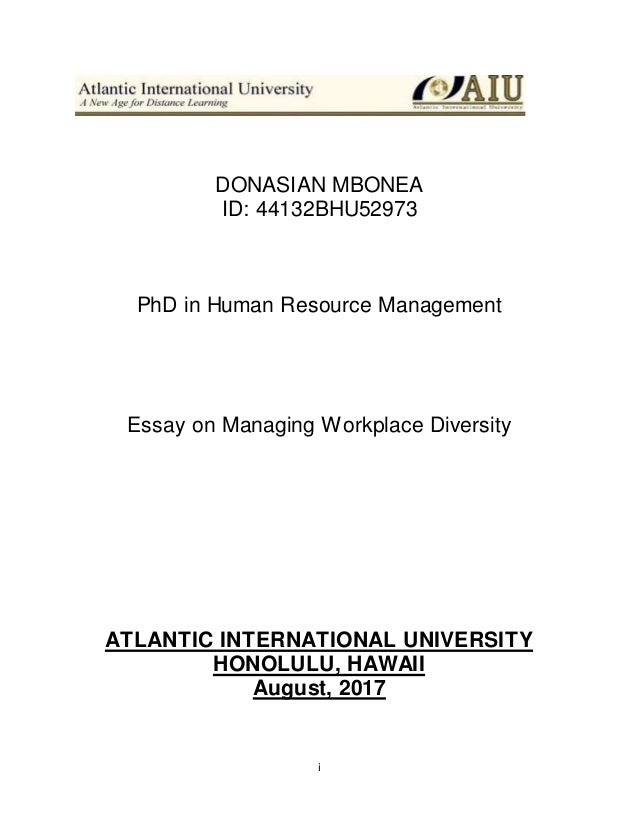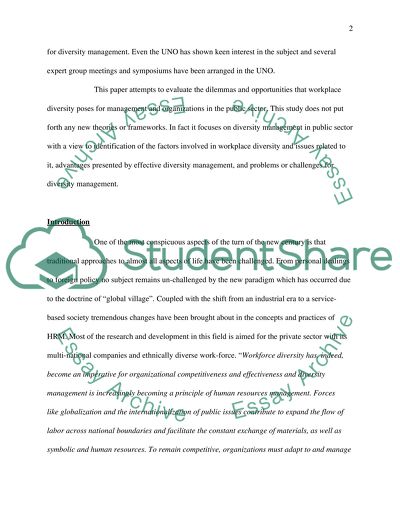
Jul 28, · Here are some research-tested strategies for learning to cultivate diversity in your life, your workplace, and your community. Practice mindfulness. New research is starting to find that cultivating non-judgmental, moment-to-moment awareness seems to reduce racial bias—an insight that may apply to other kinds of prejudice Jul 01, · How to Answer Diversity Questions in an Interview. Workplace diversity is a hot topic. A growing number of companies are attempting to make their workforces look more like the United States, reflecting the growing diversity of the nation. This means it’s becoming common at interviews to hear questions related to A century later, race and gender continue to create divergent and uneven outcomes for women of all races and for men of color. This is particularly evident in the underrepresentation and
How to Answer Diversity Questions in an Interview | Work - blogger.com
A little over years ago, the U. Congress ratified the 19th amendment, which ruled that women could not be denied the right to vote because of their sex. This amendment was the result of hard-fought efforts from many women and some men who recognized that disenfranchisement then, as now, was a blight on the nation and hindered the U.
A century later, race and gender continue to create divergent and uneven outcomes for women of all races and for men of color. This is particularly evident in the underrepresentation and experiences of women employed in professional occupations. An oft-cited statistic, for instance, reveals that as a result of factors including, but not limited to, motherhood penalties, gender discrimination, and occupational segregation, women make 79 cents for every dollar men earn.
But Black women earn only 64 cents on the dollar, workplace diversity essay, and for Latinas it is a dismal 54 cents. As it was in the early 20th century, women of color continue to experience occupational and economic disadvantages that reflect the ways both race and gender affect their work experiences.
How do racism and sexism impact women of color in professional settings? Research indicates that both factors adversely affect women in a variety of occupations through stifled leadership opportunities, workplace diversity essay, the ongoing persistence of specific forms of sexual harassment, and subtle but pervasive doubts about competence, intelligence, and skill that are unrelated to actual performance.
Research indicates that Black women are more ambitious and more likely to say that they want to advance in workplace diversity essay companies than their white women counterparts, workplace diversity essay, but are less likely to find mentors who will aid their climb up the corporate ladder. Other times, this lack of mentoring is a consequence of intentional exclusion when leaders make it a point not to include Black women in teams, as mentees, or on important projects.
And Black women are left to struggle harder to access and advance in these professions, with occupational underrepresentation and wage disparities to show for it. It workplace diversity essay important to note that these issues are not limited to Black women. In a recent study, sociologist Margaret Chin finds that Asian American women experience racialized and gendered forms of sexual harassment that leads to isolation and results in exclusion from leadership opportunities.
Latinas, too, find that coworkers may interact with them based on stereotypes that they are unintelligent or illegally in the country, depictions that then require extra work to disprove. Women of color are usually underrepresented in professional, high status jobs in law, medicine, academia, and business. Yet we know that when companies put measures into place that focus on achieving more gender diversity, women of color often lose out unless there is an explicit focus on race as well as gender.
This is not to say that white women face an easy road, particularly in professions that are disproportionately dominated by men. My recent book, workplace diversity essay, Flatlining: Race, Work, and Health Care in the New Economyhighlights how some of these intersections of race and gender impact health care professionals. Black women doctors in my study observed that both race and gender were key factors that shaped the challenges they face in the field.
Working in a profession dominated by men, Black women doctors are very attuned to the ways that sexism impacts their lives. For instance, nearly every Workplace diversity essay woman doctor with whom I spoke shared accounts of being mistaken for a nurse rather than a doctor, so much so that they argued that when it came to their everyday interactions, gender was a much more significant factor than race.
However, this unfortunately common microaggression—and the fact that, for women doctors, it transcends race—does not mean that Black women were oblivious to or shielded from racism in the medical profession, workplace diversity essay. In fact, workplace diversity essay, they astutely noted that structural factors also established a context that perpetuated racial disparities in the field. Bella, a geneticist, pointed workplace diversity essay that she entered into her field with the intention of reducing racial health disparities.
However, the extremely low numbers of Black doctors in her specialty area put her at a disadvantage when it came to finding mentors who could guide her in that goal, as most of her white senior colleagues did not share her focus on providing genetic services to Black populations who might otherwise be overlooked and ignored.
So I have not really had much luck identifying people who are working with those populations who can help me better address some of the needs workplace diversity essay some of the disparities that I see. Black workplace diversity essay in other health care professions faced different challenges. While Black women doctors encountered persistent, daily gender biases that occurred in the context of structural, racialized barriers—both of which made advancement in the profession difficult—Black women nurses reported few instances with gender biases and instead described routine, frequent, and explicitly racist encounters with colleagues.
Nurses were not employed in a culturally masculinized space like Black doctors, but in the absence of overt gender bias, they dealt with racist interactions with white coworkers. Melinda, a nurse who primarily tended to new mothers in the postpartum unit of a hospital, recounted one such interaction with a colleague, workplace diversity essay. And these experiences still varied from those of Black women technicians, who did not describe overt, explicitly gendered biases in their work, workplace diversity essay.
Rather, they described friction with mostly white women nurses who, stressed out by policies that encouraged overwork and emboldened by a lack of organizational restraint, assigned them extra work that was not delegated to white colleagues. Thus, even in spaces where Black workers are underrepresented, it is critical not to assume that they all share common experiences. These intersecting factors help highlight some of the common challenges Workplace diversity essay women workers encounter, but they also underscore that policies designed to improve gender parity in workplaces will not be workplace diversity essay if they ignore the ways that the issues women face in the workplace are also shaped by race, as well as workplace diversity essay factors—citizenship, workplace diversity essay, occupational status, workplace diversity essay, sexual identity, and more.
This also applies to companies that profess their commitment to achieving racial equity and state their opposition to systemic racism, as many are now doing in the wake of national protests against racial inequality.
It remains to be seen whether these companies will take the long-term, sustained, comprehensive actions that would be necessary to make the changes they now say they wish to see.
The good news is that there is some research that documents ways that organizations—both in health care and in other industries—can become more equitable. Changing hiring practices so that organizations pair with institutions that are known for training workers of color is a first step. For instance, workplace diversity essay, universities like Meharry Medical College and Xavier University in New Orleans produce a disproportionate number of Black students who go on to become physicians.
Organizations can partner with places like these that are renowned for training skilled Black workers, workplace diversity essay. Additionally, collecting data to understand what challenges and obstacles their workplace diversity essay are facing, particularly those from underrepresented groups, is important as well.
Companies can also directly involve managers in developing solutions, rather than tinkering around the edges of existing policies. Organizations can also workplace diversity essay paid leave for all workers—or better yet, workplace diversity essay, lobby for federal policies ensuring paid sick and parental leave policies, so that these policies are available to all workers regardless of their place of employment.
And companies can change aspects of their culture that allow sexual harassment to flourish, since, as the MeToo movement has workplace diversity essay us, this is a major problem for many vulnerable workers in virtually every industry. Ultimately, race and gender continue to matter in complicated, intersecting ways for women workers today.
While the U. has undoubtedly made some key social progressions since women finally achieved suffrage inwe run the risk of hindering further gains if we fail to learn the lessons from that time.
This piece is part of 19A: The Brookings Gender Equality Series. Learn more about the series and read published work ». Former Federal Reserve Chair Janet Yellen examines the history of women entering the labor force and analyzes both the challenges that remain today and potential solutions to meet those challenges. Andre M.
Are women happier than men? Adia Harvey Wingfield. About the Author. Adia Harvey Wingfield Professor of Sociology — Washington University in St. Her research examines how and why racial and gender inequality persists in professional occupations.
She is currently President of the Southern Sociological Society, the largest regional sociological association in the country, and is a regular contributor to SlateThe Atlanticand Harvard Business Review.
Professor Wingfield is the author of several books, most recently Flatlining: Race, Work, and Health Care in the New Economy University of California Press,workplace diversity essay, and is the recipient of the Public Understanding of Sociology award from the American Sociological Association.
More from the 19a series.
Diversity: 5 Reasons Why Workforce Diversity is Good for your Workplace
, time: 2:05Writing a Diversity Statement | Graduate Connections | Nebraska

Women in the Workplace is the largest study on the state of women in corporate America. This year’s report finds that corporate America is at a critical crossroads: 1 in 4 women are considering downshifting their careers or leaving the workforce due to the pressures created by Covid Jul 16, · Workplace diversity improves the work environment. Research shows that diverse work groups produce more cognitive processing and more exchange of information. 4 Diversity A diversity statement is a one-page document explaining your experiences and commitments to diversity. You can safely assume that any university that requests one is very committed to inclusivity and supporting their diverse population so they are looking
No comments:
Post a Comment